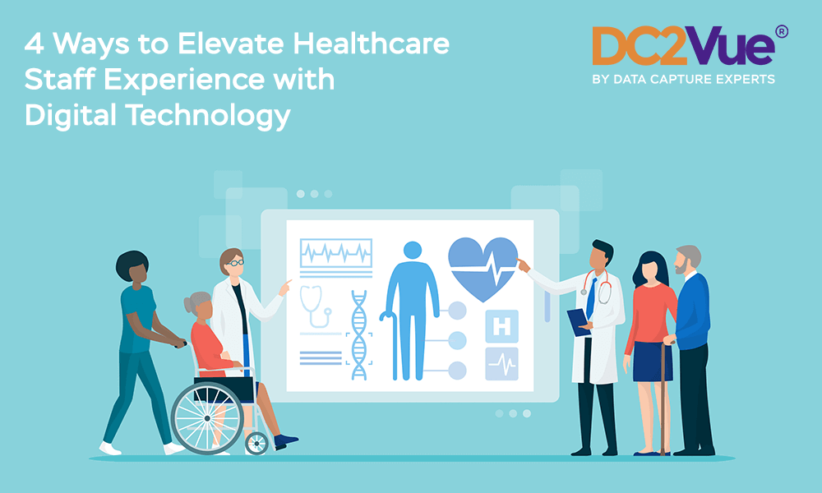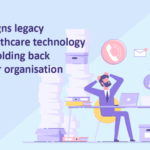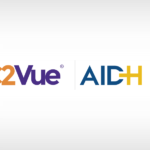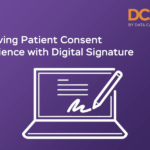(03) 9863 7644


4 Ways to Elevate Healthcare Staff Experience with Digital Technology
More than 80% of healthcare organizations currently have human experience as the highest priority to combat the #greatresignation. The transformation journey includes humancentric, process excellence and technology. Platforms like DC2Vue provide the capabilities to elevate healthcare staff experience and integrate with other clinical tools with common service data model concepts.
If empowering healthcare workforce teams through digital technology is the current focal point of your strategy, the following four steps will go a long way to yielding the results you crave.
#1 Enabling multidisciplinary team care
Every successful healthcare business relies heavily on fast and transparent communication. Therefore, enabling multidisciplinary team care must be a priority for all owners and executives working in this field.
Clear and consistent collaborations are the driving force behind world-class patient care. Modern solutions should subsequently look to connect nurses, administrators, allied health, and mental health teams to increase communication between interdepartmental teams and their team members. Not least because it has been statistically shown that poor communication by health care professionals may lead to life-threatening complications.
Inadequate communication between teams isn’t only an issue that impacts patients. American research shows that a 500-bed hospital could lose an average of USD$4m per year due to communication inefficiencies. Australian companies that persist with outdated tech features or rely exclusively on items like pagers can expect to see similarly damaging impacts.
There are plenty of devices and software solutions to support businesses with their interdepartmental communication. When considering healthcare technology and employee experience, though, it’s important to choose a solution that is built exclusively with healthcare teams in mind. Tools like DC2Vue are the perfect choice because they;
- Guarantee compliance with all relevant regulations.
- Enable clinical information to be shared instantly for increased transparency and reduced errors.
- Ensure that clinical data is shared securely.
- Provide a single platform to manage all incoming and outgoing referrals, as well as integrated Smart dashboards.
The DC2Vue platform for hospitals and other healthcare settings also provides clear layouts and an easy interface that encourages improved accessibility for individual and collaborative patient care matters. When workflow speeds improve, the staff experience becomes far less stressful too - not least because doctors, nurses, and carers can focus on the patient rather than tech troubleshooting.
#2 Enabling a Hybrid Workplace
The coronavirus pandemic has changed the landscape forever, not least when it comes to healthcare. Healthcare providers have had to adapt to new patient care protocols, which subsequently means a new approach to the worker experience is needed. Facilitating hybrid workplaces is a particularly pertinent feature.
Over 28% of the Australian population has now used telehealth services to receive medical support. Meanwhile, many healthcare businesses have found themselves faced with on-site difficulties due to Covid cases and social distancing requirements. Digital technology can open the door to work from home and hybrid opportunities in situations where they are deemed appropriate or necessary. In the current climate, it has become a key ingredient in the recipe for maintaining smooth healthcare operations, not least for organisations hoping to reduce clinician burnout.
Our managed cloud services help accelerate the digital transformation, which subsequently supports healthcare businesses as they adapt to the circumstances of post-pandemic patient care. Some examples of its implementation include;
- Enabling timely and secure access to patient records from anywhere.
- Facilitating easy patient care across multi-site locations.
- Supporting healthcare teams who need to provide telehealth or in-home visits.
- Enabling workers to continue work at home when ill or taking care of loved ones.
- Maintaining optimal efficiency even if outside factors like the pandemic take a toll.
Hybrid workplaces ultimately deliver versatility, thus empowering healthcare workforce teams on a daily basis. From finding improved workflow strategies to overcoming temporary obstacles, staff experiences will be elevated by these features with immediate and ongoing results.
Studies in the UK show that happy workers are 13% more productive while the figure could be even higher in medical or healthcare settings. The use of a digital platform that additionally automates and streamlines various admin processes will only further support the bid for increased employee happiness and engagement levels.
#3 Fit-for-purpose clinical and operational workflows with user-centred design
Time is a valuable resource in all business environments. However, it can quite literally be the difference between life and death in some healthcare settings. Delays due to communication are a known major source of malpractice claims, and it’s not only patients who can suffer from workflows that are not fit-for-purpose.
A huge 28% of nurses in Australia plan to quit, and the figure is largely attributed to poor platforms that are not centred around the user or ineffective in clinical settings. Digital tech solutions that are built specifically for healthcare teams reduce clinician burnout by avoiding the need for data entry duplication while also keeping data efficiently stored and instantly accessible.
Fast loading times, real-time data, and easy navigation are all key features that make a platform suited to clinical and operational workflows. Whether it’s individual processes or collaborative efforts, you can elevate the staff experience by removing manual procedures and enabling teams to focus on utilising data and providing world-class patient care.
Crucially, NDIS-compliant tools can be integrated to support all workers regardless of past experiences in the industry or with the facilities themselves. Some of the key features include;
- Enabling junior staff and locum staff to make calculated decisions.
- Making tasks easier for busy clinical staff thanks to quick access to clinical data.
- Tech solutions where healthcare companies can use fast training processes.
- Supporting clear, data-driven clinical decisions for employees at all levels.
- Allowing users to seek confirmation from colleagues with ease.
In clinical settings, working with speed and assurance is vital. The right tech tools go a long way to making this happen by managing key data metrics and completing various assignments under one platform, even when information needs to be transferred between different sites and locations.
#4 Process measures to drive patient outcome measures
As already mentioned, communication is a priority for all healthcare providers. However, it’s not just about internal interactions between staff members. The link between workers and patients is an equally crucial factor. Collecting and responding to feedback will ultimately lead to improved patient care while simultaneously serving as the driving force behind happy workplaces for employees.
Statistics show that 80% of patients actively prefer digital interactions, which is why using online channels to collect this information is far more likely to secure a strong response rate. Not least because they can complete surveys and feedback forms at a suitable time for them. Again, the automated nature of sending out the requests creates a better staff experience.
Crucially, feedback can be analyzed through automated tools and tech-generated visual representations, thus allowing teams to keep enhancing the patient care game. It is far from the only way that statistical measurements can be used, though. Other benefits include;
- Undertake clinical audits of your healthcare business performance levels.
- Participate in research, either internally or externally.
- Enable live data to promote real-time decision-making,
- Completing daily operating system huddles.
When using the DC2Vue Plus, it will be possible to use a range of reporting tools alongside assessment and care planning facilities to gain a clear understanding of where things currently stand. More importantly, it enables care teams to identify areas of improvement and build a clear pathway to greater success - for patients and staff experiences alike.
Australia’s healthcare sector is worth $171bn, and patient demands are naturally at an all-time high. If digital tech can facilitate greater accessibility and reduced stress for workers, it has to be the key cog in the machine for achieving healthcare process excellence for the rest of 2022 and beyond.
Summary
Empowering healthcare workforce teams is a key step to cultivating a better healthcare setting for employees and patients alike. With solutions for hospitals and clinics, mental health, home care, NDIS, and community health ventures readily available, companies across the sector can now improve staff experiences with truly telling results.
Let's work together to create a better healthcare staff experience and transform patient outcomes. Claim your free 30-minute consultation to see how we can help your business today.







